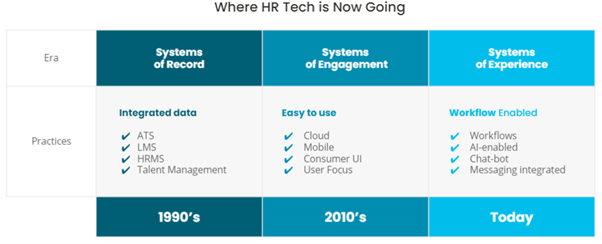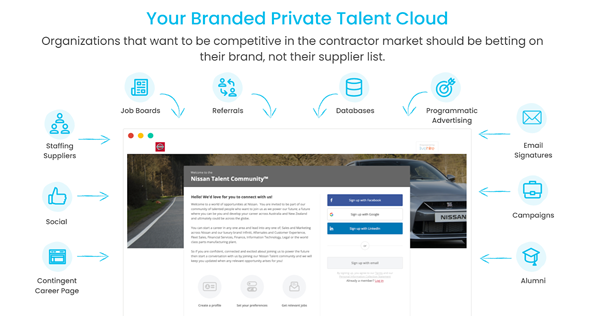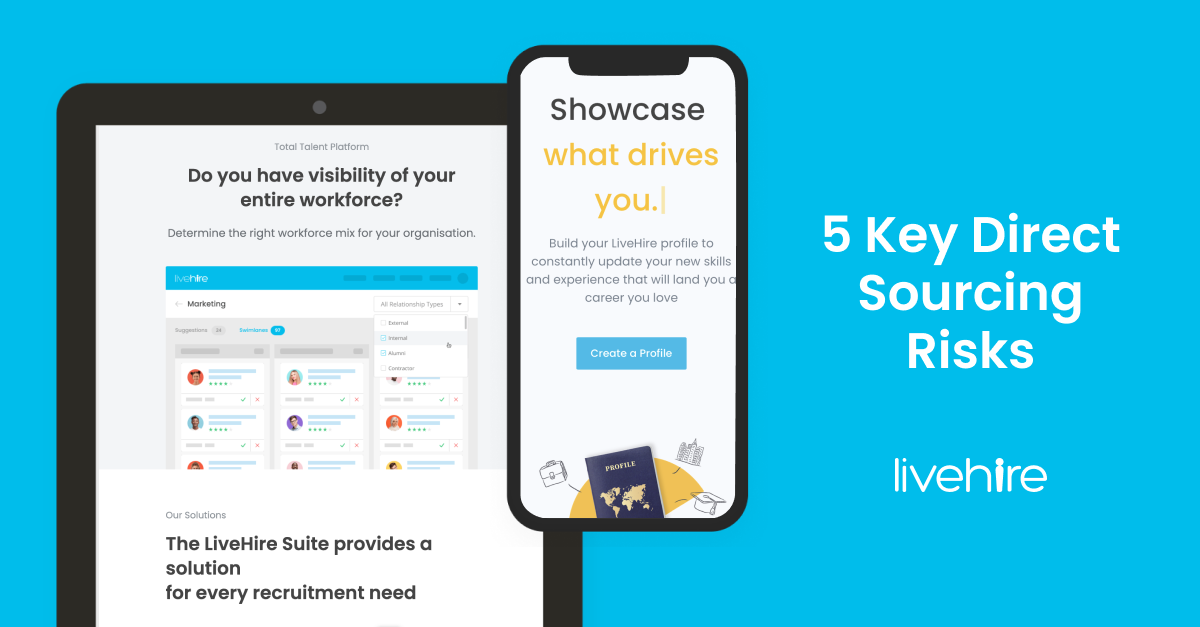
At some point in the early stages of implementing a Direct Sourcing strategy, you will undoubtedly find yourself at a technology crossroads, wondering what technology is required to drive a successful Direct Sourcing strategy. Further, how is this technology different to your current technology stack? And does it even connect with your current contingent workforce program stack?
What additionally compounds things are the claims of certain technology providers that they are an all-in-one solution. However, the best in breed approach is key to successful Direct Sourcing programs.
This article uncovers the differences between Vendor Managements Systems (VMS) and Direct Sourcing (DS) technology, assisting you to determine what you will need to achieve Direct Sourcing program success.
Both Vendor Managements Systems (VMS) and Direct Sourcing (DS) technology play an integral part in delivering Direct Sourcing outcomes, but there is often confusion surrounding why you need both and the specific role each plays.
Defining a Vendor Management System
We feel the team at SAP Fieldglass offer a great definition of a VMS and the value it can offer:
“A VMS, or Vendor Management System, is a cloud-based software platform that solves a common problem for many global enterprises – how to manage its external workforce – both contract or contingent labor and services providers.
With an increasingly complex and multi-channelled global workforce, enterprises must gain clear insight into who is working for them, where, why, when, and at which rates.”
So, what is the core function of a VMS?
Core Functionality of a Vendor Management System
The role of the vendor management system is to be the system of record within your contingent workforce program. There have been many investments, innovations, and iterations to form the VMS that we know today. For definition purposes the overarching core functionality of a Vendor Management System includes:
- Job requisition or staff ordering
- Automatic billing
- Business intelligence (BI) functionality
- Management reporting
- Workflow engines
- Amenity tracking
- Service catalogue, including standardized positions and skills
As you can see from the flow of the functionality, it all starts with the raising of a job requisition or staffing order and then flows right through the process from there. This is critical functionality for any large, complex enterprise to maintain accurate information. That said, there are inherent trade-offs between large ‘systems of record’ and the type of user experience we’ve all come to expect from consumer technology.
Industry thought leader Josh Bersin has written extensively on the topic of HR technology and the gradual migration from ‘systems of record’ to systems of engagement and experience. The image below is inspired by some of his latest views on this topic.

Similar to a HR system of record that maintains employee information, the introduction of VMS technology continues to play a critical role for advanced back office compliance and efficiency. While many VMS technologies continue to evolve and improve, they are often lacking in features that enable a consumer-like experience. That brings us to Direct Sourcing technology…
Defining Direct Sourcing Technology
As contingent workforce programs evolve, it’s more critical than ever to pair VMS technology with the ability to source and engage contractors at-scale, while delivering a world class candidate experience.
LiveHire has been leading the way in this by providing a deeply integrated experience layer for your VMS that is intuitive and engaging.
Direct Sourcing software is still relatively new in the market. Also known as a ‘digital staffing platform’, the leading global research conducted by Ardent Partners for the Digital Staffing Platforms Technology Advisor Report defines digital staffing platforms as solutions that enable:
- Curation of freelancers, contractors, and professional services into private talent clouds.
- Automation of end-to-end Direct Sourcing capabilities and processes.
- Recruitment-specific functionality built to serve hiring managers and contingent workforce business leaders.
- Ability to build branded job portals and similar offerings to drive both active and passive candidates to talent pools and talent communities.
- Functionality related to “Freelancer Management Systems” (FMS).
- Functionality to manage projects and initiatives supported by non-employee talent (including SOW management).
- Talent-matching capabilities for project/role-to-candidate alignment.
- Full payment, invoicing, and settlement for non-employee workers.
- Compliance and risk mitigation of independent contractor, tax, regulatory, and related issues.
- Reporting and analytics to measure cost, quality, performance, impact, etc. of non-employee talent.
- Intelligence related to predictive skills gaps, expertise shortfalls, future talent needs, etc.
- Integration with workforce management platforms, such as Vendor Management Systems (VMS), Applicant Tracking Systems (ATS), Human Resources Information Systems (HRIS), and similar technology.
There is a nuanced difference that we need to flag here between Direct Sourcing platforms and digital staffing platforms, as the field of Direct Sourcing technology is emerging and fast growing Ardent Partners include digital staffing as a term so that it can incorporate freelancer management. For this reason, of the 12 bullet points featured above, we’ll only be including details on the 7 that relate to Direct Sourcing platforms.
7 Core Functionalities of a Direct Sourcing Platform
1. Curation of freelancers, contractors, and professional services into private talent clouds
If you’ve read our ‘Conclusive Guide to Direct Sourcing for Contingent Workforce Programs’, you’ll know that deciding who manages the talent curation is key, either you get resources internally or take on a Managed Direct Sourcing strategy and partner with a leading staffing supplier to be your curator of talent. With either choice of curator though, functionality that enables you to easily source contingent talent from a multitude of channels and invite them into your talent cloud, with easy join functionality is key. Doing this without a modern technology solution makes it nearly impossible to engage the contingent workforce and keep your data up-to-date.
2. Automation of end-to-end Direct Sourcing capabilities and processes
If you’re anything like us, having multiple applications open at any one time is a productivity killer and can lead to human error. Direct Sourcing technology is much the same, so what is key with this functionality is that every step of your sourcing process is configured on-platform.
As you transition to a Direct Sourcing strategy you can also use talent pool milestones. For example here at LiveHire we transition seamlessly from supplier sourcing to Managed Direct Sourcing for each requisition when your corresponding talent pools reach 40% of target depth. This helps to improve hiring manager experience and rapid adoption. All this is possible by the automation of end-to-end Direct Sourcing processes.
3. Recruitment-specific functionality built to serve hiring managers and contingent workforce business leaders
When you dig into all the Direct Sourcing technology platforms studied by Ardent Partners, you’ll note most are anchored on the candidate relationship management software that you need, and this CRM is key for managing relationships with candidates. LiveHire’s unique approach combines CRM and ATS functionality, producing a better end to end hiring experience. To complement the CRM, you also need the functionality of a modern Applicant Tracking System. A great ATS offers you functionality for Direct Sourcing such as:
- Configurable recruitment workflows
- Allows for high-volume hiring
- Applicant screening and management
- AI-suggested talent matching
- And interview scheduling and management
4. Ability to build branded job portals and similar offerings to drive both active and passive candidates to talent pools and talent communities
One of the key points of Direct Sourcing is it activates your employer brand, better engaging contingent workers with your mission and values. This is a key criteria when making a technology decision. Your technology of choice needs to be completely company branded and able to receive prospective contingent workers from all channels:

5. Talent-matching capabilities for project/role-to-candidate alignment
This functionality is well established by Ardent Research as it enables curation of candidates for future hires or re-deploying current contractors. As an example. LiveHire AI identifies and suggests the best candidates for requisitions in real time, with the highest submittal-to-hire conversion rate of all Direct Sourcing Platforms (33%).
6. Reporting and analytics to measure cost, quality, performance, impact, etc. of non-employee talent
It is every business’s expectation today that they make informed, evidence-based decisions. And transitioning to a Direct Sourcing strategy is no exception; the technology is there to do just this. In fact, this functionality is only going to become more important over time.
To further elaborate on what this should look like, here at LiveHire we have been investing heavily in our reporting and analytics suite. We can say with confidence that best-in-class reporting and analytics gets you:
- Dashboards that you can easily translate, are interactive and you can visualize to ensure you get actionable insights, ultimately driving more informed decisions
- Tailored ad-hoc reports and dashboards available on-demand to provide critical information to senior management
- The ability to link to external BI tools of your choosing so you can incorporate hiring data into your organization-wide dashboard, gaining consistent analysis and reporting efficiencies
7. Integration with workforce management platforms, such as Vendor Management Systems (VMS), Applicant Tracking Systems (ATS), Human Resources Information Systems (HRIS), and similar technology
With the availability of APIs today, and other methods of integration, this is always achievable and of paramount importance. By ensuring you have the right integration in place you both receive efficiency gain and also eliminate the possibilities of human error.
While we have you…
If you have read this far, Direct Sourcing technology is likely a priority for you. If you got value from this article, we hope you’d get value from learning more about our Direct Sourcing technology. LiveHire has developed deep institutional knowledge about how to deliver turnkey Managed Direct Sourcing solutions for our clients.
It’s what we do and we do it well, along with our Managed Direct Sourcing partners when required across sourcing, curation, and payroll. We’ve invested heavily in technology development and implemented hundreds of new Talent Clouds for best known and trusted brands across all major industries.
What we’ve learned over the years has shaped and reshaped our best practice approach. LiveHire employs a rapid, structured and scalable implementation methodology, we refer to this simply as the LiveHire ‘approach’. Our approach is supported by best-in-class project management practices to consistently deliver projects on time, on budget with minimal fuss.



